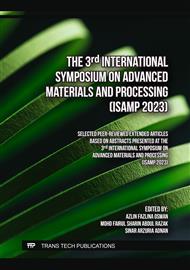[1]
J. Leidner, "Plastics Waste: Recovery of Economic Value," MARCEL DEKKER, INC., 270 MADISON AVE., NEW YORK, NY 10016, USA. 1981., 1981.
DOI: 10.2134/jeq1981.00472425001000020034x
Google Scholar
[2]
L. Kean Chong, A. F. Osman, A. A. Ahmad Fauzi, A. A. Alrashdi, and K. A. Abdul Halim, "The Mechanical and Thermal Properties of Poly (ethylene-co-vinyl acetate)(PECoVA) Composites with Pristine Dolomite and Organophilic Microcrystalline Dolomite (OMCD)," Polymers, vol. 13, no. 18, p.3034, 2021.
DOI: 10.3390/polym13183034
Google Scholar
[3]
J. Lu and H. J. Sue, "Morphology and mechanical properties of blown films of a low‐density polyethylene/linear low‐density polyethylene blend," Journal of Polymer Science Part B: Polymer Physics, vol. 40, no. 6, pp.507-518, 2002.
DOI: 10.1002/polb.10115
Google Scholar
[4]
N. Roslan et al., "Optimisation of shrinkage and strength on thick plate part using recycled LDPE materials," Materials, vol. 14, no. 7, p.1795, 2021.
DOI: 10.3390/ma14071795
Google Scholar
[5]
F. A. Mesquita, "Modificação das propriedades do polietileno de alta densidade por diferentes condições de extrusão," Universidade de São Paulo, 2010.
DOI: 10.11606/d.3.2010.tde-10012011-103025
Google Scholar
[6]
M. Barletta, C. Aversa, M. Puopolo, and S. Vesco, "Extrusion blow molding of environmentally friendly bottles in biodegradable polyesters blends," Polymer Testing, vol. 77, p.105885, 2019.
DOI: 10.1016/j.polymertesting.2019.05.001
Google Scholar
[7]
J. Aurrekoetxea, M. Sarrionandia, I. Urrutibeascoa, and M. L. Maspoch, "Effects of recycling on the microstructure and the mechanical properties of isotactic polypropylene," Journal of materials science, vol. 36, pp.2607-2613, 2001.
DOI: 10.1023/a:1017983907260
Google Scholar
[8]
Malaysian Plastics Manufacturers Association (MPMA), "Annual Survey on the Use of Recycled Plastics in Malaysia," Malaysian Plastics Manufacturers Association (MPMA), Kuala Lumpur, Malaysia2022.
Google Scholar
[9]
H. L. Chen, T. K. Nath, S. Chong, V. Foo, C. Gibbins, and A. M. Lechner, "The plastic waste problem in Malaysia: management, recycling and disposal of local and global plastic waste," SN Applied Sciences, vol. 3, pp.1-15, 2021.
DOI: 10.1007/s42452-021-04234-y
Google Scholar
[10]
N. Sombatsompop and S. Thongsang, "Rheology, morphology, and mechanical and thermal properties of recycled PVC pipes," Journal of applied polymer science, vol. 82, no. 10, pp.2478-2486, 2001.
DOI: 10.1002/app.2098
Google Scholar
[11]
M. M. Raj, H. V. Patel, L. M. Raj, N. K. Patel, and R. Patel, "Studies on mechanical properties of recycled polypropylene blended with virgin polypropylene," Int. J. Sci. Invent. Today, vol. 2, no. 3, pp.194-203, 2013.
Google Scholar
[12]
S. Paida, R. Koster, L. Kinget, and L. Cardon, "Properties of mixtures of recycled and virgin polypropylene homopolymer," in Proceedings of the 6th International Polymers & Moulds Innovations (PMI) Conference, Guimarães, Portugal, 2014.
Google Scholar
[13]
C. Javierre, A. Fernandez, and V. Camanes, "Influence of the Recycled Material Percentage on the Mechanical Behaviour of HDPE for Injection Moulding Process for an Ecologycal Design," Advanced Materials Research, vol. 445, pp.935-940, 2012.
DOI: 10.4028/www.scientific.net/amr.445.935
Google Scholar
[14]
M. Wenguang and F. L. Mantia, "Processing and mechanical properties of recycled PVC and of homopolymer blends with virgin PVC," Journal of applied polymer science, vol. 59, no. 5, pp.759-767, 1996.
DOI: 10.1002/(sici)1097-4628(19960131)59:5<759::aid-app1>3.3.co;2-w
Google Scholar
[15]
H. Rajandas, S. Parimannan, K. Sathasivam, M. Ravichandran, and L. S. Yin, "A novel FTIR-ATR spectroscopy based technique for the estimation of low-density polyethylene biodegradation," Polymer Testing, vol. 31, no. 8, pp.1094-1099, 2012.
DOI: 10.1016/j.polymertesting.2012.07.015
Google Scholar
[16]
S. Khruengsai, T. Sripahco, and P. Pripdeevech, "Low-density polyethylene film biodegradation potential by fungal species from Thailand," Journal of Fungi, vol. 7, no. 8, p.594, 2021.
DOI: 10.3390/jof7080594
Google Scholar
[17]
A. D. Chigwada, H. J. O. Ogola, and M. Tekere, "Multivariate analysis of enriched landfill soil consortia provide insight on the community structural perturbation and functioning during low-density polyethylene degradation," Microbiological Research, p.127425, 2023.
DOI: 10.1016/j.micres.2023.127425
Google Scholar
[18]
J. Gulmine, P. Janissek, H. Heise, and L. Akcelrud, "Degradation profile of polyethylene after artificial accelerated weathering," Polymer degradation and stability, vol. 79, no. 3, pp.385-397, 2003.
DOI: 10.1016/s0141-3910(02)00338-5
Google Scholar
[19]
J. Gulmine, P. Janissek, H. Heise, and L. Akcelrud, "Polyethylene characterization by FTIR," Polymer testing, vol. 21, no. 5, pp.557-563, 2002.
DOI: 10.1016/s0142-9418(01)00124-6
Google Scholar
[20]
A. S. Dey, H. Bose, B. Mohapatra, and P. Sar, "Biodegradation of unpretreated low-density polyethylene (LDPE) by Stenotrophomonas sp. and Achromobacter sp., isolated from waste dumpsite and drilling fluid," Frontiers in Microbiology, vol. 11, p.603210, 2020.
DOI: 10.3389/fmicb.2020.603210
Google Scholar



